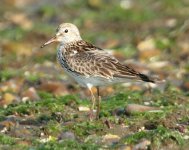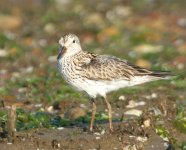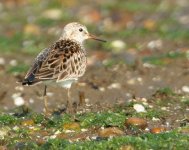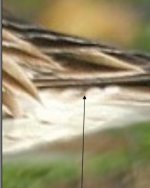-
Welcome to BirdForum, the internet's largest birding community with thousands of members from all over the world. The forums are dedicated to wild birds, birding, binoculars and equipment and all that goes with it.
Please register for an account to take part in the discussions in the forum, post your pictures in the gallery and more.
You are using an out of date browser. It may not display this or other websites correctly.
You should upgrade or use an alternative browser.
You should upgrade or use an alternative browser.
Sandpiper (1 Viewer)
- Thread starter searobin
- Start date
More options
Who Replied?streatham said:Looks like a White-rumped to me - long wings - flank streaking.
Luke
How about the color of its legs? Shouldn't they be darker/black on a White-rumped?

streatham said:Looks like a White-rumped to me - long wings - flank streaking.
Luke
For me it's not a White-rumped because of the yellow bill and leggs.
Fritz73 said:For me it's not a White-rumped because of the yellow bill and leggs.
Well I'd have to say in reply that the bill isn't yellow - it has an red/orangish base to the lower mandible which is a feature of breeding WR. The leg coloration isn't yellow either - I imagine is just slightly brighter due to the light.
Some nice comparative pics here: http://www.featheredfotos.com/spppages/shorebirds/white-rumped sandpiper.html
http://www.roysephotos.com/WhiteRumpedSandpiper.html
Last edited:
atricapillus
Well-known member
__________________________streatham said:Well I'd have to say in reply that the bill isn't yellow - it has an red/orangish base to the lower mandible which is a feature of breeding WR. The leg coloration isn't yellow either - I imagine is just slightly brighter due to the light.
Some nice comparative pics here: http://www.featheredfotos.com/spppages/shorebirds/white-rumped sandpiper.html
http://www.roysephotos.com/WhiteRumpedSandpiper.html
I would agree with Streatham; odd reflectance off the legs, but still a White-rumped Sandpiper. Long primaries, extending well past tail, some chevrons in the side streaking; streaking on a pretty whitish base color. Good jizz, bill for WRSA.
CHEERS, JOE G
I tried hard but I really couldn't make this bird a White-rumped Sandpiper 
For me it's more like a 1st summer Pectoral Sandpiper (possibly a female) :
- heavily worn grey coverts and tertials are indicative of 1st summer
- legs are pale (even if pale legged White-rumped Sandpiper exist)
- tibia is really too long for White-rumped Sandpiper but is fine for Pectoral Sandpiper this makes a shape quite unusual for a White-rumped Sandpiper (but ok for Pectoral Sandpiper)
- bill is too long with wrong shape and too pale for White-rumped Sandpiper but is fine for Pectoral Sandpiper
- primary projection is very long but tertials are worn (there is one tertial missing on left wing ??).
- breast is not well streaked for a Pectoral Sandpiper but that's would be ok for 1st summer bird which "forgot" to moult (or just a poorly marked female).
This is my analysis, in my humble opinion, the bird is a Pectoral Sandpiper.
(A possible female because of smaller bill and lighter breast)
For me it's more like a 1st summer Pectoral Sandpiper (possibly a female) :
- heavily worn grey coverts and tertials are indicative of 1st summer
- legs are pale (even if pale legged White-rumped Sandpiper exist)
- tibia is really too long for White-rumped Sandpiper but is fine for Pectoral Sandpiper this makes a shape quite unusual for a White-rumped Sandpiper (but ok for Pectoral Sandpiper)
- bill is too long with wrong shape and too pale for White-rumped Sandpiper but is fine for Pectoral Sandpiper
- primary projection is very long but tertials are worn (there is one tertial missing on left wing ??).
- breast is not well streaked for a Pectoral Sandpiper but that's would be ok for 1st summer bird which "forgot" to moult (or just a poorly marked female).
This is my analysis, in my humble opinion, the bird is a Pectoral Sandpiper.
(A possible female because of smaller bill and lighter breast)
Motmot
Eduardo Amengual
atricapillus said:__________________________
I would agree with Streatham; odd reflectance off the legs, but still a White-rumped Sandpiper. Long primaries, extending well past tail, some chevrons in the side streaking; streaking on a pretty whitish base color. Good jizz, bill for WRSA.
CHEERS, JOE G
Also agree
Grousemore
Senior Member
White-rumped for me.
JANJ
Well-known member
First I thought to my self, is Th_SQ the only sensible person on this Tread  Because first summer female Pectoral was my emediate impression. But the long wings, jizz, especially in pic.2, and lower scapular pattern had me change to WRS. It does look long-legged and with greenish legs, which is not such a big deal, greenish legs I mean, though I have seen WRS with similar long-legged appearance! There are a slight tendency to chevrons on the flank, and obvious streaks on rear flank as well, good for WRS, but shared with many PS. Looking at pic.3 and the lower scapulars, they would be a perfect match for WRS. On each feather there´s an obvious pale base, quite typicall for WRS and to my knowledge, not seen in such an extent in PS.
Because first summer female Pectoral was my emediate impression. But the long wings, jizz, especially in pic.2, and lower scapular pattern had me change to WRS. It does look long-legged and with greenish legs, which is not such a big deal, greenish legs I mean, though I have seen WRS with similar long-legged appearance! There are a slight tendency to chevrons on the flank, and obvious streaks on rear flank as well, good for WRS, but shared with many PS. Looking at pic.3 and the lower scapulars, they would be a perfect match for WRS. On each feather there´s an obvious pale base, quite typicall for WRS and to my knowledge, not seen in such an extent in PS.
So I think WRS on this one.
Have a look at this one, just to compare bill pattern, to mention one similarity:
http://www.surfbirds.com/media/gallery_photos/20060616052642.jpg
JanJ
So I think WRS on this one.
Have a look at this one, just to compare bill pattern, to mention one similarity:
http://www.surfbirds.com/media/gallery_photos/20060616052642.jpg
JanJ
Chris Benesh
So much work, so little time...so let's go birding
JANJ said:Have a look at this one, just to compare bill pattern, to mention one similarity:
http://www.surfbirds.com/media/gallery_photos/20060616052642.jpg
JanJ
It is worth pointing out too that JanJ's White-rumped example also shows the pale legs featured on the mystery bird, as well as the bill coloration. I agree that it is a White-rumped, though perhaps the posture shown in the photo (i.e., upright and alert) imparts a somewhat Pectoral Sandpiper feel that we've all noticed.
Chris
Jane Turner
Well-known member
Th_SQ said:Waoh, such a clear unanimity for White-rumped ! Must be that I'm wrong (but still unconvinced, but who cares).
Never seem a a pec look like that plumage-wise but am willing to believe its possible. What about the structure... leg length, bill shape, body shape......? WRS always look low, horizontal and "cringy/creepy" to me - having remarkably little height from ground to the top of back. Unless its just bad luck that the three pics show it upright and perky looking. Also curious as to how it can have flecking on sides of the rump just above the tail feathers.
How was it in the field, did it move like a WRS or a Pec?
Attachments
Last edited:
JANJ
Well-known member
Like this Jane:
http://www.birdsireland.com/images/2004/august/whiterump.jpg
and on some here:
http://www.featheredfotos.com/spppages/shorebirds/white-rumped sandpiper.html
JanJ
http://www.birdsireland.com/images/2004/august/whiterump.jpg
and on some here:
http://www.featheredfotos.com/spppages/shorebirds/white-rumped sandpiper.html
JanJ
doug_newman
Well-known member
Hi All.
Here is my measured reply.
1) Pectoral basically has no wing projection so that should rule out Pectoral.
2) Pectoral's paelr base to the bill is on upper and lower mandible and extends slightly further on the upper than the lower. Here it seems only to be confined to the lower mandible, also ruling out Pectoral.
3) Pectoral has a notable downcurved bill - not seen on this bird.
4) The pale tips to scapulars leave a clear line down the back on Pectoral - also not ssen here.
5) Juv White-rumped has bright rufous and buff edges to upperparts and a contrastingly pale hind-neck - seems ok for this bird.
6) WRS has bill black with base of lower mandible tinged greenish or yellowish-brown - Ok for this bird
7) WRS has black legs that can be sometimes fintly tinged greenish.- Depends on the photo colour tone etc but may explain the non-blak legs.
8) Shorebirds does state that the uppertail in some plumages of WRS may be lightly marked brownish or greyish - May explian some of the markings that seem to be seen on some shots of this bird.
9) Assume this was taken today, looking at the feather wear etc. Firstly there is no greyish suffusion on the breast so it is not juvenile. That would mean it is not juv yet it has the juv paler hind neck. The coverts seem fairly well worn and look alot more like winter plumage but there are breeding plumage feather comming through strongly on the mantle. Might this not then be a first summer Adult bird with some traces of the juv plumage not yet moulted out? (I think I can see a few greyish spots on the breast which would be traces of the juv suffused grey on the streaked breast). That might explain non-standard feather patterns some people have referred to?
10) If shorebirds pics are very very accurate, WRS shows a more collared effect at the top of the streaked breast which is seenhere and is not equally represented in Pectoral Sandpiper.
I would say White-rumped Sandpiper.
Cheers.
Doug.
Here is my measured reply.
1) Pectoral basically has no wing projection so that should rule out Pectoral.
2) Pectoral's paelr base to the bill is on upper and lower mandible and extends slightly further on the upper than the lower. Here it seems only to be confined to the lower mandible, also ruling out Pectoral.
3) Pectoral has a notable downcurved bill - not seen on this bird.
4) The pale tips to scapulars leave a clear line down the back on Pectoral - also not ssen here.
5) Juv White-rumped has bright rufous and buff edges to upperparts and a contrastingly pale hind-neck - seems ok for this bird.
6) WRS has bill black with base of lower mandible tinged greenish or yellowish-brown - Ok for this bird
7) WRS has black legs that can be sometimes fintly tinged greenish.- Depends on the photo colour tone etc but may explain the non-blak legs.
8) Shorebirds does state that the uppertail in some plumages of WRS may be lightly marked brownish or greyish - May explian some of the markings that seem to be seen on some shots of this bird.
9) Assume this was taken today, looking at the feather wear etc. Firstly there is no greyish suffusion on the breast so it is not juvenile. That would mean it is not juv yet it has the juv paler hind neck. The coverts seem fairly well worn and look alot more like winter plumage but there are breeding plumage feather comming through strongly on the mantle. Might this not then be a first summer Adult bird with some traces of the juv plumage not yet moulted out? (I think I can see a few greyish spots on the breast which would be traces of the juv suffused grey on the streaked breast). That might explain non-standard feather patterns some people have referred to?
10) If shorebirds pics are very very accurate, WRS shows a more collared effect at the top of the streaked breast which is seenhere and is not equally represented in Pectoral Sandpiper.
I would say White-rumped Sandpiper.
Cheers.
Doug.
London Birder
Well-known member
also at first glance thought Pec but WRS for me also on most of the above ... primary projection alone would rule out Pec
JANJ
Well-known member
Th_SQ said:Having spent some time looking again carefully at the pictures, checking litterature and reading answers I have to admit I was wrong : it can only be a White-rumped Sandpiper. Sorry for stupidly following my instinct ... :gn:
You will rise again! o
JanJ
Users who are viewing this thread
Total: 2 (members: 0, guests: 2)







